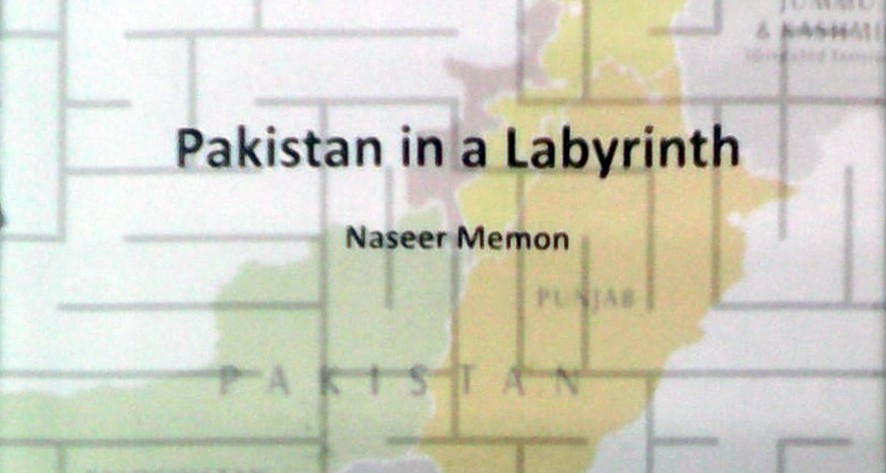
A thought-provoking book that tries to present an objective picture of the state of affairs in Pakistan

"It is a riddle, wrapped in a mystery, inside an enigma; but perhaps there is a key"
When Winston Churchill delivered this remark in a radio broadcast in October 1939, he was talking about Russia but 75 year later when we look at Pakistan, this strikes a chord. Finding Pakistan in a labyrinth -- as Naseer Memon puts it -- is not a pleasant experience. It makes you oscillate between sheer despondency and some rays of hope flickering through the shadows. And what mighty shadows are highlighted by Memon in this collection of articles: of porous borders in danger of being redrawn; of extremism that has darkened the societal texture; of gloominess emanating from radicalisation of society; and of obscurity devouring rationalism.
Naseer Memon calls himself a development professional but, from his analytical articles, he emerges as a social critic par excellence. He cites examples from across the globe; for example, discussing the legacies of the two General Zias -- Zia-ul-Haq of Pakistan and Zia-ur-Rahman of Bangladesh -- he draws comparisons between the Islamisation processes of the two who used religion to entrench the military’s supremacy in politics.
A recurrent theme in his articles is the desire to see the country become free of religious intolerance. In his article ‘Sindh Under Assault of Obscurantism’, he recounts Sindh’s history of mutual accommodation and harmony. He laments the faith-based violence imposed upon the people by the religious right bolstered by the state while the liberal, nationalist and secular segments of society are persecuted and hounded.
Memon reminds us of some great personalities who became victims of state-sponsored vilification campaigns when it suited the establishment and paid respect to by army generals when it was deemed beneficial. From a piece on G M Syed, the readers get a glimpse of this towering figure who "stood for separation of religion from state affairs and advocated greater autonomy for federating units". This was a sin of enormous magnitude in the eyes of the standard-bearers of an elusive nation state that was never to be. Hence, G M Syed "for his defiant views, remained interned for over 30 years" despite his "treasure trove of over 60 published books and a huge cache of unpublished work".
Be it the promulgation of Anti-terrorism Act (ATA 2011) or Protection of Pakistan Ordinance (PPO 2013), the writer raises his concerns in unequivocal terms; he has no soft corner for those who violate human rights under the garb of state protection and their blemished record is overlooked when they are armed with unbridled powers and showered with praise for defending the ‘national sovereignty’ while the public interests are compromised again and again by the same gun-wielding morons.
The books gives us substantial data to draw our conclusions from rather than relying on emotional statements to incite our sentiments. In a brilliant article ‘Between Bread and Bullets,’ the reader is prompted to think with the following:
"Today, India and Pakistan boast 3rd and 8th largest armies in the world. India maintains a regular army of 1.32 million. Adding reserve force and paramilitary the number swells to 4.7 million. Pakistan has a regular army of 0.61 million. Reserve and paramilitary forces jack up the total to 1.4 million. Hence India and Pakistan have 3.9 and 8.2 soldiers per 1000 population which indicates a larger military-density in Pakistan…..India ranked 8th and Pakistan 25th on military spending among 152 countries ….. with human development index where they rank 136th and 146th."
The writer is a strong proponent for devolution of power to the local level but not with an uneven distribution of wealth; he longs to bridge the development gap between rural and urban areas, and retaliates furiously at the suggestion of dividing Sindh on ethnic basis.
Normally, newspaper articles have a short shelf life; pertinent on the day they are printed and used to wrap groceries the next; opinion pieces tend to be even more fleeting. But Naseer Memon’s write-ups are supported by solid facts and figures that make them long lasting. Most of the 38 articles in this collection appeared during the past couple of years in some of the leading English newspapers in Pakistan but, surprisingly, the editing is not up to the mark. This reflects on the overall declining journalistic standards in the country.
The book is well-produced but the articles should have been put together under appropriate sections such as the articles on Sindh could be in one section. A thought-provoking book, it tries to present an objective picture of the state of affairs in Pakistan and is likely to generate an interest in the intellectual circles and students of Pakistan affairs.